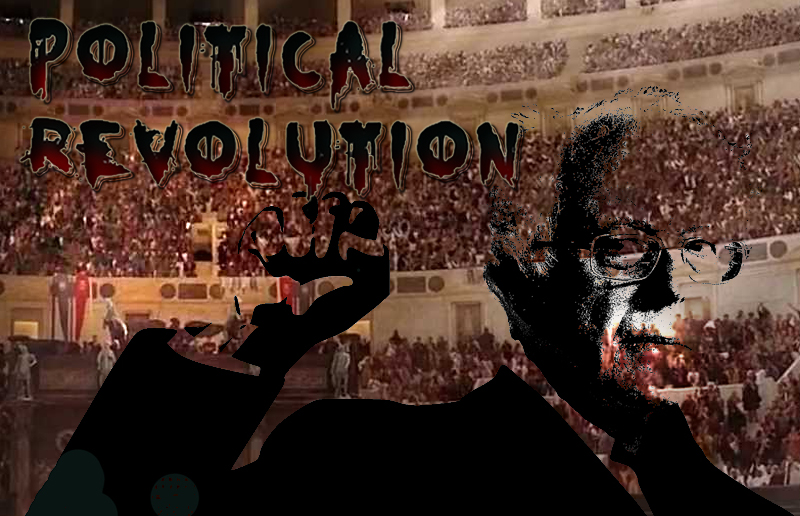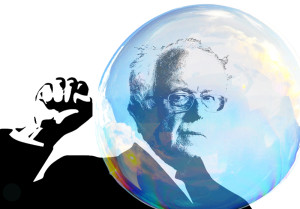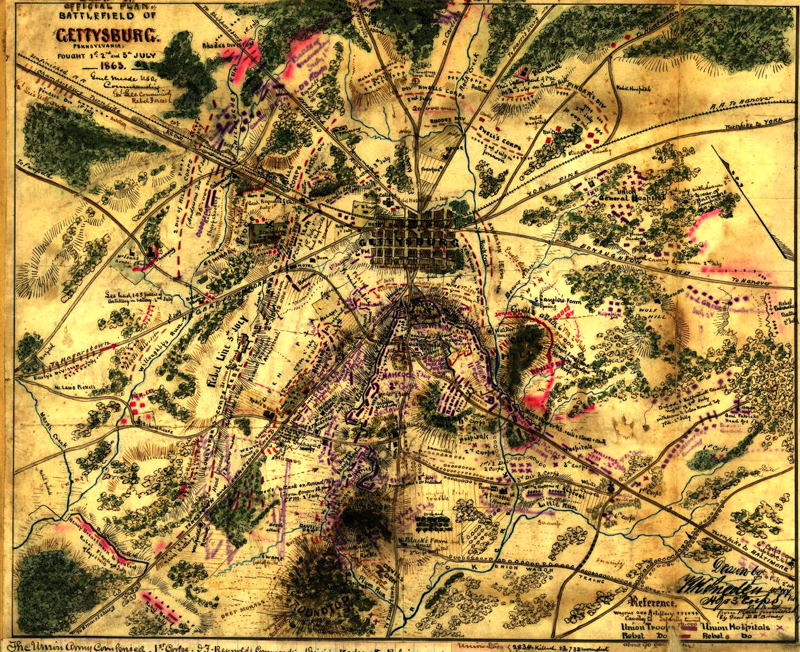 Millions have been energized, enlisted and mobilized into the Sanders campaign under the banner of the Political Revolution. But as Charlotte Corday sang in the play Marat/Sade, “change meant one thing to you I see / And something quite different to me.”
Millions have been energized, enlisted and mobilized into the Sanders campaign under the banner of the Political Revolution. But as Charlotte Corday sang in the play Marat/Sade, “change meant one thing to you I see / And something quite different to me.”
At a December gathering of Tampa Bay area Sanders volunteers, national staffer Corbin Trent was asked what the Sanders campaign was planning to do to organize the Black community in Florida, given that Sanders was “getting creamed” with the Black vote in South Carolina. His answer: make lots of phone calls to white voters in Iowa.
In a New Year’s Eve missive from the campaign called “THIS is what a political revolution looks like,” Team Bernie presents a list of recent small donors, then asks, “Can Bernie count on you to make a $3 contribution right now?” and explains that this is “about transforming America,” etc. Yes! Yes! Yes! … So?
Okay, I just sent in my $3. Now what?
Getting out the vote in the early primary states is certainly important. Solid fundraising is critical. Left insurgent campaigns are all-too-often plagued by rank amateurism, if not downright incompetence. And to make matters worse, such incompetence is proudly extolled as a virtue, a measure of a campaign’s grassroots character.
That the Sanders campaign is so well run, is raising big-league funds without relying on corporate coffers, is an enormous strength. This campaign is about making a Political Revolution, as Sanders clearly states, and you better be raking in some big bucks, and you better be showing some professionalism. But is that revolutionary?
As I have said before, “Thou shalt not take the word Revolution in vain!” A revolution is much more than a movement. There have been many movements in this country. There have been many grassroots campaigns in this country. But damned few revolutions.
Then just what is the Political Revolution beyond a catchy advertising slogan? What will it look like on the Bloody Morning After, when the last primary has been held, when the convention has chosen its nominee, when the votes are tallied come November 8? Alas, the campaign allows no space for discussing what Revolution would entail other than exhorting the troops to work harder and give more. Raise money. Make phone calls. Eat your spinach. End of discussion.
The Bernie Bubble.
 Ironically, the supposed inevitability of Bernie’s victory is used to quash any broader discussion, all is administration. What to do after the primaries? No time for discussing that now, on to the convention! After the convention? Never mind, on to the general election! After the election? Redecorate the White House. A simple person might think that the inevitability of Sanders’ victory echoing within the Bernie Bubble makes such discussion of long-term issues more pressing than ever. Is this mere foolishness? Or is it a hustle by party professionals?
Ironically, the supposed inevitability of Bernie’s victory is used to quash any broader discussion, all is administration. What to do after the primaries? No time for discussing that now, on to the convention! After the convention? Never mind, on to the general election! After the election? Redecorate the White House. A simple person might think that the inevitability of Sanders’ victory echoing within the Bernie Bubble makes such discussion of long-term issues more pressing than ever. Is this mere foolishness? Or is it a hustle by party professionals?
We need to be discussing how we pursue the Political Revolution. Now.
The Revolution must be organized.
First on the agenda is the distinction between “organization” and “movement.” In a recent piece, “Mass consciousness and its discontents,” I put forward:
“[A]pplied to social movements, as Woody Guthrie put it, they ‘come with the dust and are gone with the wind,’ they are as ephemeral as the snows of yesteryear.
“This is not just a quarrel over semantics. The problem is that movement is wrenched out of the relationship between organization and mass movement, a relationship which is ill understood by the U.S. Left, and deliberately obscured by media and academia (if they can see at all) which want to bury that relationship.”
 I have argued that the battle lines are not just between Sanders and his people versus the billionaire class, but between the Sanders campaign and the Democratic Party establishment. But as is becoming clear, there is an equally important struggle WITHIN the Sanders campaign itself. Will this be a traditional campaign but “grassrootsier”? Or something that won’t evaporate when the official campaign flicks off the lights? (Where are the McGoverns of yesteryear?) An organization embracing the entire Sanders movement, one that can carry on a fight that is only beginning.
I have argued that the battle lines are not just between Sanders and his people versus the billionaire class, but between the Sanders campaign and the Democratic Party establishment. But as is becoming clear, there is an equally important struggle WITHIN the Sanders campaign itself. Will this be a traditional campaign but “grassrootsier”? Or something that won’t evaporate when the official campaign flicks off the lights? (Where are the McGoverns of yesteryear?) An organization embracing the entire Sanders movement, one that can carry on a fight that is only beginning.
At this point, some might be wondering what I myself mean by Political Revolution. How do I think we should bring it about? Not with the left, that’s for sure. The left is utterly atomized, completely demoralized. (Where are the demonstrations of two years ago?) They despair. In their desperation some are even beginning to hope that Trump becomes our next president. Nothing like a little fascism to wake the masses up.
But there is no excuse for despair. I hate despair like Indiana Jones hates snakes. Despair is the escape hatch of the lazy. To begin:
Step One. We do have to recognize that very little is immediately possible. But “very little” is a lot better than “nothing.” This DIFFICULT state of affairs is merely our starting point.
Okay, so you might ask, why the hell would I call that a master plan? I don’t call it a master plan. I don’t have one. Anyone who claims to have one is simply a charlatan. The social-material conditions do not yet exist for drafting master plans. Those conditions have yet to be created. By us.
Time out for a philosophical interlude. The Machinist.
 A late friend of mine was in his early days a machinist, working a lathe. His machines did not produce cars. His machines did not turn out refrigerators. He produced absolutely nothing that could be directly used by the consuming public. He produced tools. Or more accurately, he produced tools that produced tools that produced tools, etc. Thus the machine that would finally crank out a Ford’s right front fender was itself the product of a complex production process that was unintelligible to the end consumer.
A late friend of mine was in his early days a machinist, working a lathe. His machines did not produce cars. His machines did not turn out refrigerators. He produced absolutely nothing that could be directly used by the consuming public. He produced tools. Or more accurately, he produced tools that produced tools that produced tools, etc. Thus the machine that would finally crank out a Ford’s right front fender was itself the product of a complex production process that was unintelligible to the end consumer.
Then what “tools” are required to ultimately generate the Political Revolution?
Some bright lad might jump the gun and pipe up, “Hold a Political Revolution conference!” Yes, of course. But even generously conceding the merits of this (and what august body exists to even discuss holding this conference?), there are questions upon questions to get from this bold suggestion to its implementation.
Step Two. Be part of the Sanders campaign. Why is this Step Two? Because without Step One, “recognize that very little is possible,” we would be prone to over-reaching, which upon failure would lead to despair. It puts our feet on the ground. So millions of us are part of the Sanders campaign, in different states, doing different things, with different hopes and dreams and visions. But at least here we are. So far, so good.
Step Three. Understand the terrain. We are operating within the parameters of a traditional Democratic Party presidential campaign. No? Yes, as evidenced by, if nothing else, Sanders’ pledge to support Hillary should she gain the Democratic nomination. This is the 500-pound donkey in the room. That there is not already a vibrant discussion of the Political Revolution beyond as a marketing slogan is prima facie evidence that those at the top do not really want that discussion. If they wanted it, we would already be finding ways to have it. I would not deny that there are merits to “playing the game,” but the rules the official campaign MUST play by do not have to be OUR rules.
We are working against a fragmented social milieu that is not amenable to building solid, accountable organization. The campaign has characteristics of the “tyranny of the leaderless group,” exacerbated by the superficiality of the atomized Facebook culture. The national campaign did not generally create official state organizations. This was touted as grassroots democracy in action. But it allowed the national operation to directly incorporate Sanders volunteers across the country, and to bypass the local structures. With this setup, when they turn out the lights at the end of the campaign, the lights go out all over the country.
Step Four. Build independent Sanders groups that are strong enough to hold themselves together beyond the current election cycle. There is space to operate within the campaign. In some places, Sanders groups are doing so.
Do not forget that we have the 14% of Sanders supporters who have stated that they will not vote for Hillary in the general election. Add to that those who hold their noses while voting for Hillary, and we have something to work with, if we can find a way.
Some options.
In “Mass consciousness and its discontents,” I suggested four options for the movement, should Sanders fail to win the primaries or be nominated at the Democratic National Convention:
(1) Have them all join the Green Party.
(2) Form a radical caucus inside the Democratic Party.
(3) Break away and form a new party.
(4) Create a different kind of organization that includes Democrats, Republicans and independents.

Tiger Option 1, or Tiger Option 2, or Tiger Option 3, or Tiger Option 4, or the Lady Jill Stein.
First, the very phrase “have them all” leads down a false trail. Harking back to my machinist friend, nobody is in a position to “have them all” do anything. There is no cohesive “they” to decide anything, let alone implement it. There is an important political unity around a broad progressive politic. But organizationally?
We need to figure out, then, how to work with what we have, where people are, and begin to take the most basic steps. As with my machinist friend, we need tools. We need to figure out what tools we need to build the tools we need.
In that light, steps (1), (2) and (3) are off the table for the immediate future, but are worthy of further exploration. However, while point (1), “go into the Green Party,” would open up a can of snakes (we might not even be welcome there), there is maybe Option (1a) of voting for the leading Green presidential candidate Jill Stein, should (heaven forbid!) Sanders not be the Democratic nominee. Stein is openly courting the Sanders vote, while respecting the Sanders campaign for raising issues similar to the ones she is raising. A dramatic increase over the 469,501 votes (0.36%) would make a significant statement for the Political Revolution, even if her absolute numbers remained small.
Still, while the Stein Option (1a) is doable, it does not answer what is to be done after November 8. Option (4), on the other hand, potentially offers an alternative that starts with what we actually have, and gives us some tentative organizational form.
One feisty Texan.

Linda Curtis.
A leading proponent of Option (4) is Linda Curtis, a leading spokesperson, analyst and tactician for the Texas independent political movement Curtis has a long history in independent politics, from her early efforts gaining ballot access for the first woman and African-American to get on the ballot for President in all 50 states (Lenora Fulani in 1988), to being a co-founder of the League of Independent Voters of Texas, which is tackling San Antonio’s Vista Ridge Project, a corporate boondoggle that could devastate the Edwards Aquifer, and threatens real harm to the communities overlying the source aquifers and to property owners, communities, and the environment along the 142-mile corridor of the proposed pipeline.
Curtis works outside the box. The “box” is the utterly sterile debate between those who insist that progressives must work within the Democratic Party, and those who insist that we must immediately be forming an independent progressive party. The debate is sterile as the arguments haven’t really changed a whit since 1968, and at this point, no one from either camp is about to be persuaded to quit their low-down ways. In addition, not every “third-party” adherent is really independent and not every Democrat is a slave of Wall Street.
In her 2012 “Who will organize the Independents?” Curtis outlines an approach that avoids these sterile debates and allows groups to work together who would not normally be seen in the same room together. First she outlines the problems independents of every stripe face:
“Who will organize the Independents?”
American political theater has, of late, followed a familiar storyline.
In 2008 Barack Obama entered stage left. Subsequent events quickly showed that change would not come from within the Democratic Party. What changed was Obama — from a transformational figure to a transactional negotiator.1
A similar scenario has unfolded on stage right. The Tea Party, initially sparked by the Ron Paul Presidential run was, in short order, commandeered by the Koch machine and other familiar figures within the GOP establishment. They too will prove that their party is impotent to bring change that is progress to America.
Throughout the unfolding drama, mainstream liberal and conservative stakeholders have performed their familiar dance. Progressives and libertarians have each laid claim to their nominal parties, pursuing a strategy that is trying to affect political change by taking control of either of the major parties. But they have had their agendas systematically undermined as a deeply entrenched establishment has co-opted or marginalized them.
Independents have experienced our own painful realities and shortcomings. We witnessed them during the implosion of the Reform Party, which had burst onto the political scene following Ross Perot’s first presidential run in 1992. Within five years the movement and the party were dead, in part, due to its own internal power struggles. I served as the chief organizer for the Reform Party of Texas and held a position on the National Committee of the Reform Party of America. In 2001, together with other independents, we formed Independent Texans, the only voter association in Texas seeking recognition for approximately 5 million non-aligned Texas voters.
The independents have learned from these events. First, we learned that there is no change to be had within the current political paradigm. The old paradigm of “left/right” has been replaced. Perot himself talked about it in his second run for the Presidency — America is about the few at the top running the show, with the rest of the people down at the bottom taking orders. And now we’re learning that despite our failure to consolidate an organization out of the independent movement, the movement by ordinary Americans, nevertheless continues to the outside of both parties. The jury is still out on what, specifically, can be built that will succeed.
Is the American political stage set, yet again, for another outbreak of the independent movement? Will it be another “third party”, or another major independent candidacy? Will it be more localized? Could it be a “third force” — a movement — that moves inside and outside all political parties? And, how will it be built and funded? The purpose of this paper is to spur discussions that bring some answers to those questions, with a focus on Texas.
Curtis asserts a few basic principles:
 Independents are a diverse group of people across the political spectrum — from Tea Partiers to Green Partiers. We are people who agree on little else than the fundamentals that have been lost in two-party politics; honesty, fiscal conservatism, stewardship of natural resources, and a competitive electoral environment. Independents by no means want the same things. …
Independents are a diverse group of people across the political spectrum — from Tea Partiers to Green Partiers. We are people who agree on little else than the fundamentals that have been lost in two-party politics; honesty, fiscal conservatism, stewardship of natural resources, and a competitive electoral environment. Independents by no means want the same things. …
A September 2010 Gallup poll shows that over the last seven years, the support for a third party in America has risen. Tea party supporters favor a third party by 62%. Independents now favor a third party by 74% and, interestingly, liberals and moderates tend to be more pro-third party than conservatives.
Independents have argued for decades that we need at least three options to win qualitative change. But how do we get there, since the major party duopoly so thoroughly controls the electoral system? Though we see a dire need for fundamental election reform, that’s not necessarily where we should start in the midst of America’s current melt down. We might better start by inserting independent politics into the growing crises in ordinary citizen’s lives as they are crying out for help. All of these are related to the continuing contraction of the American economy and the unraveling of the welfare state. What will replace it? That question will not be answered by politicians because politicians cannot answer it. It must be answered by the citizenry if American democracy is to progress. …
Independents are not primarily at the “center” of a political system that is now a corporatist den of deal making — so much so that one must question whether the “political center” even exists. No Labels makes the claim that the process for consensus has collapsed by virtue of the activists within the major parties controlling the show in primaries. But, the truth is that activists within the parties do not run the parties, despite their connections to the base. Just ask Debra Medina about the Republican Party of Texas — she is frustrated. Just ask any number of progressives about the Democratic Party — Obama broke their hearts. …
As mentioned earlier, we are not advocating for a third party. Our experiments point us towards a lean central organization that consciously positions itself within the evolving network of identity conscious “tribes” or “nodes of active citizens” as they push up from the bottom against the corporatist state and corporatist parties. Local grassroots groups will manifest themselves in response to each unfolding crisis, as they did with the TTC. By creating and sharing value with these organizations, as well as already existing ones, we can form and shape a movement that defines itself actively, as opposed to via the tired, polemical, alienating politics and partyism of the past.
Another philosophical interlude.
 Things look dark for the American people and people all around the world. Right-wing gunmen seize federal buildings with impunity. Battle lines are being drawn in the Middle East. The Sanders movement is a ray of light amid all this. But can it prevail? The forces against us constitute a formidable monolith. The empire is striking back with a vengeance.
Things look dark for the American people and people all around the world. Right-wing gunmen seize federal buildings with impunity. Battle lines are being drawn in the Middle East. The Sanders movement is a ray of light amid all this. But can it prevail? The forces against us constitute a formidable monolith. The empire is striking back with a vengeance.
But a funny thing happens with empires. As they conquer all, the forces of progress do not vanish from the earth, nor does any conquered people. Rather, the forces that the empire was so thirsty to conquer re-emerge WITHIN the empire, even as they take different forms, different labels. Thus the chaos reigning in American politics today. Whatever party controls the legislatures and the White House, the fundamental fact is that the political system is completely out of sync with the American people. Whatever its prospects, the Curtis plan is designed to be able to maneuver within a political scene where alliances and labels are shifting daily, to exploit this discordance.
Monoliths are quite fragile creatures.
“We are what we are!”

I yam what I yam!
The Curtis plan’s beauty is that it takes people where they are. A party, any party, is exclusionary almost by definition. You are a member, or you are not. Platforms and programs are grounds for contention. You either agree with Article XIV, subparagraph (6) or you don’t. We don’t need to start out by figuring out who to exclude. The only “exclusion” I would insist on — as the Sanders campaign certainly insists — is that we are not to be beholden to the billionaire class. That is not an exclusion based on ideology. It is an exclusion based on interests, and I do believe that there are conflicting interests.
The IWW put it well: “The working class and the employing class have nothing in common. There can be no peace so long as hunger and want are found among millions of working people and the few, who make up the employing class, have all the good things of life.”
On paper, there are a great variety of Master Plans that would work, if only … if only … But the “if only’s” abound. Trying to pick the one true path, when there is insufficient critical mass to put any of them into action, is a formula for endless sectarian warfare. Options (1), (2), (3) and (4)? If you can make any of them work, have at it! For a while, I toyed with the notion of figuring out the “best” option. That was a mistake on my part.
Yes, it could be argued that the Curtis plan is very vague. But that very vagueness is a virtue. It calls on people of whatever stripe to find common ground in action, without necessarily becoming something other than what they are. As Popeye said, “I am what I am!”
So I am a registered Democrat, though some (Green and Democrat alike) might prefer that I weren’t. I have friends among the Green Party who somehow put up with my occasionally harsh critiques of the Green Party. I have no intention of trying to get Greens to register Democrat, nor am I trying to get Democrats to register Green.
Let’s talk about it.
— submitted by jeff roby
January 6, 2016


One must make clear that the better and farther the Sanders campaign goes, up to (god willing) the White House, the better for the revolution.
Keep your eyes on the superdelegates, they are why I say Green. Only one party refuses cprp cash. Jill2016.com/plan
Bernie is also refusing corporate cash. Should Bernie fail to get the nomination, Stein is the way to go.
Before revolution, you must understand the bureaucracy of the system. Concentrating on a single, ‘man on a white horse’ candidate, is usually a disaster which opens the door to strongman politics. Successful revolution means grassroots elected officials – the school board, county clerk and municipal boards. That’s how the Moral Majority did it. Congress was spawned in State legislatures, where fascism first took hold after Reagan/Bush.Think Texas. That can be reversed, but only by reclaiming government at the local level. That, in turn, drives higher bureaus to conform to local policies. Executives are administrators, not revolutionaries. Unless they come with… Read more »